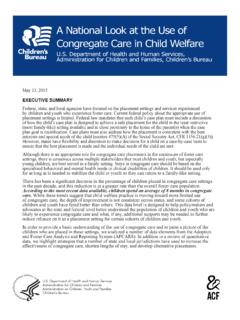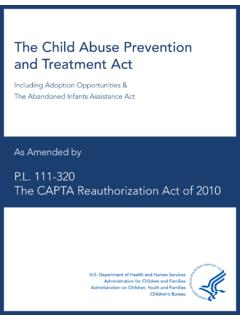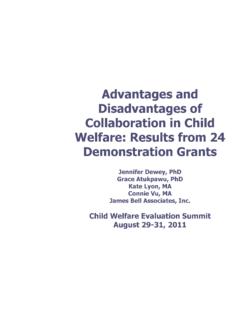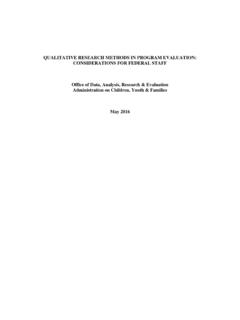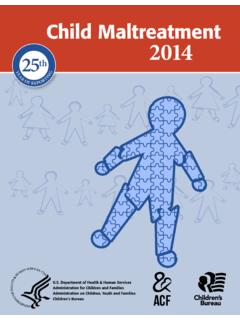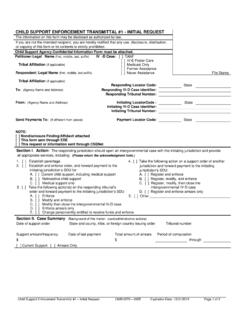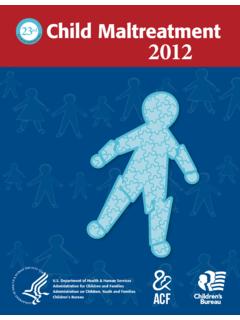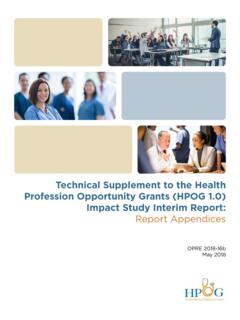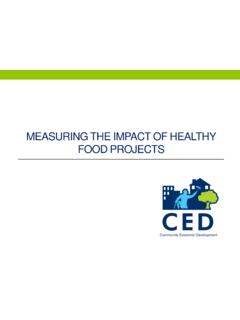Transcription of Caring for Our Children Basics Health and Safety ...
1 2015 Caring for Our Children Basics Health and Safety Foundations for Early care and Education Administration for Children and Families Department of Health and Human Services 6/25/2015 1 Contents Acknowledgements .. 4 Introduction .. 5 Staffing .. 8 Ratios for Centers and Family child care Homes .. 8 Background Screening .. 8 Pre-service Training/Orientation .. 9 First Aid and CPR Training for Staff .. 9 Continuing Education for Directors, Caregivers/Teachers in Centers, and Family child care Homes .. 9 child Abuse and Neglect Education .. 9 Program Activities for Healthy Development .. 10 Monitoring Children 's Development/Obtaining Consent for Screening .. 10 Personal Caregiver/Teacher Relationships for Birth to Five-Year-Olds.
2 10 Methods of Supervision of Children .. 10 Supervision near 10 Preventing Expulsions, Suspensions, and Other Limitations in Services .. 11 Prohibited Caregiver/Teacher Behaviors .. 11 Health Promotion and Protection .. 12 Active Opportunities for Physical Activity .. 12 Safe Sleep Practices and SIDS Risk Reduction .. 12 Routine Oral Hygiene Activities .. 12 Diaper Changing Procedure .. 12 Situations that Require Hand Hygiene .. 13 Routine Cleaning, Sanitizing, and Disinfecting .. 13 Prevention of Exposure to Blood and Body Fluids .. 13 Use of Tobacco, Alcohol, and Illegal Drugs .. 13 Emergency Procedures .. 14 Recognizing and Reporting Suspected child Abuse, Neglect, and Exploitation .. 14 Preventing and Identifying Shaken Baby Syndrome and Abusive Head Trauma .. 14 Sun Safety Including Sunscreen .. 14 Strangulation Hazards .. 14 2 care Plan for Children with Special Health care Needs.
3 14 Inclusion/Exclusion/Dismissal of Children .. 15 Infectious Disease Outbreak Control .. 15 Medication Administration and Storage .. 15 Training of Caregivers/Teachers to Administer Medication .. 16 Nutrition and Food Service .. 16 Use of Department of Agriculture (USDA), child and Adult care Food Program (CACFP) Guidelines .. 16 Availability of Drinking Water .. 16 care for Children with Food Allergies .. 16 Preparing, Feeding, and Storing Human Milk .. 17 Preparing, Feeding, and Storing Infant Formula .. 17 Warming Bottles and Infant Foods .. 18 Foods that Are Choking Hazards .. 18 Food Preparation Area Access .. 18 Compliance with Food and Drug Administration (FDA) Food Code and State and Local Rules .. 18 Facilities, Supplies, Equipment, and Environmental Health .. 18 Inspection of Buildings .. 18 Compliance with Fire Prevention Code .. 18 Environmental Audit of Site Location.
4 18 Guardrails and Protective Barriers .. 19 Safety Covers and Shock Protection Devices for Electrical Outlets .. 19 Location of Electrical Devices near Water .. 19 Integrated Pest Management .. 19 Use and Storage of Toxic Substances .. 19 Carbon Monoxide Detectors .. 19 Safety of Equipment, Materials, and Furnishings .. 19 Availability and Use of a Telephone or Wireless Communication Device .. 20 Cribs and Play Yards .. 20 Firearms .. 21 : First Aid and Emergency Supplies .. 21 Play Areas/Playgrounds and Transportation .. 21 3 Location of Play Areas near Bodies of Water/ Enclosures for Outdoor Play Areas/Enclosure of Bodies of Water .. 21 Prohibited Surfaces for Placing Climbing Equipment .. 21 Inspection of Indoor and Outdoor Play Areas and Equipment .. 22 Lifesaving Equipment .. 22 Water in Containers .. 22 Qualifications for Drivers .. 22 child Passenger Safety .
5 23 Interior Temperature of Vehicles .. 23 Passenger Vans .. 23 Infectious Disease .. 23 Immunization Documentation .. 23 Unimmunized Children .. 24 Immunization of Caregivers/Teachers .. 24 Policies .. 25 Written Plan and Training for Handling Urgent Medical care or Threatening 25 Disaster Planning, Training and Communication/Emergency and Evacuation Drills .. 25 Sign-In/Sign-Out System .. 25 Authorized Persons to Pick Up child .. 26 Record of Valid License, Certificate, or Registration of Facility or Family child care Home .. 26 Contents of child Records .. 26 Frequency of Inspections for child care Centers and Family child care Homes .. 26 Resources Consulted in Development .. 27 4 Acknowledgements Caring for our Children Basics is based on Caring for Our Children : National Health and Safety Performance Standards; Guidelines for Early care and Education Programs, Third Edition.
6 We would like to acknowledge the extensive work of the American Academy of Pediatrics; American Public Health Association; National Resource Center for Health and Safety in child care and Early Education; and Maternal and child Health Bureau, Department of Health and Human Services in developing these standards. We would also like to especially thank the following experts for their help in this effort: Abbey Alkon, RN, School of Nursing University of California, San Francisco Judy Collins Consultant Richard Fiene, Research Institute for Key Indicators Walter Gilliam, Edward Zigler Center in child Development and Social Policy Yale University child Study Center Danette Swanson Glassy, MD, FAAP American Academy of Pediatrics Barbara Hamilton, MA Maternal and child Health Bureau Health Resources and Services Administration Department of Health and Human Services Pauline D. Koch Koch Consulting Marilyn Krajicek, , RN, FAAN National Resource Center for Health and Safety in child care and Early Education College of Nursing University of Colorado Denver Beverly Schmalzreid, Department of child Development South Texas College Nancy Von Bargen, MS Office of child care National Center for child care Quality Improvement Jeanne VanOrsdal, M.
7 Ed. Early Education and child care Initiatives American Academy of Pediatrics Marcus Williams National Association for Regulatory Administration 5 Introduction Evidence continues to mount that demonstrates the profound influence Children s earliest experiences have on later success. Nurturing and stimulating care given in the early years builds optimal brain architecture that allows Children to maximize their potential for learning. Interventions in the first years of life are capable of altering the course of development and shift the odds for those at risk of poor outcomes toward more adaptive ones. To meet the needs of our nation s most vulnerable Children and families, the early care and education programs administered by the Administration for Children and Families (ACF) are designed to both provide enriching early childhood experiences that promote the long-term success of Children and assist low-income working parents with the cost of child care .
8 In partnership with families, all early care and education programs should support Children 's needs and age-appropriate progress across domains of language and literacy development; cognition and general knowledge; approaches to learning; physical Health and well-being and motor development, and social and emotional development that will improve readiness for kindergarten. Head Start, Early Head Start, pre-Kindergarten, and child care programs aim to support the ability of parents, teachers, child care providers and other community members to interact positively with Children in stable and stimulating environments to help create a sturdy foundation for later school achievement, economic productivity, and responsible citizenship. ACF strives to achieve the following goals in all early childhood programs: Build successful Early Learning and Development Systems across Early Head Start, Head Start, child care , and pre-Kindergarten.
9 Promote high quality and accountable early learning and development programs for all Children . Ensure an effective early childhood workforce. Improve the physical, developmental, mental Health , and social well-being of Children in early learning and development settings. Promote family engagement and support in a child s development with the recognition that parents are their Children 's primary teachers and advocates. Build on the strengths and address the needs of culturally and linguistically diverse Children and families. Improve the Health and Safety of early learning and development settings While high quality early care and education settings can have significant developmental benefits and other positive long term effects for Children well into their adult years, poor quality settings can result in unsafe environments that disregard Children 's basic physical and emotional needs leading to neglect, toxic stress, injury, or even death.
10 As a result, it is not surprising that Health and Safety has been identified in multiple parent surveys as one of the most important factors to consider when evaluating child care options (Shlay, 2010). Health and 6 Safety practices provide the foundation on which states and communities build quality early care and education settings. licensing of center-based care and family child care homes is a process that establishes the minimum requirements necessary to protect the Health and Safety of Children in care . State licensing requirements are regulatory requirements, including registration or certification requirements, established under State law necessary for a provider to legally operate and provide child care services. From 2009 to 2011, more than half of states made changes to licensing regulations for center-based care and family child care homes. For example, states increased the pre-service training requirements for center directors, and increased the number of ongoing training hours for all center staff roles, as well as family child care providers.
